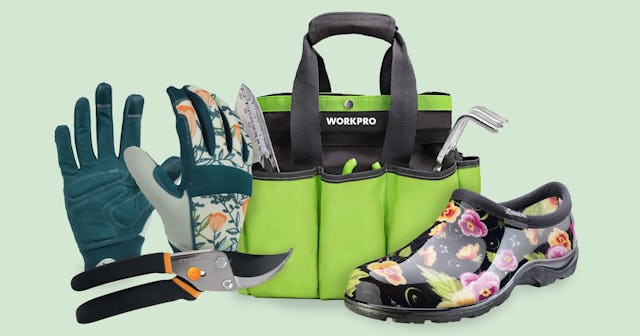12 Of The Best Gardening Tools, Products, & Organizers— Green Thumb Not Required

Most of us care about the appearance of our lawn and garden — especially now during the summer of coronavirus, when backyard activities are some of the safest (and only!) activities we can do. With many city dwellers ditching metropolitan vibes for #ThatSuburbsLife amidst corona, new homeowners are learning the ropes about what it means to have grass, a garden, and how the hell to take care of them both.
In fact, a new lawn care survey reports that 53 percent of U.S. adults who care for their own property say a well-maintained lawn is most important to curb appeal (second only to the home).
So, if you’re just getting into gardening and aren’t sure where to start, we consulted Dr. Gladys Mbofung-Curtis, an expert plant pathologist and seed physiologist, about what amateur gardeners should know. In other words, #Gardening101.
“The lawn should be fertilized properly,” Dr. Mbofung-Curtis says. “Cool-season grasses should be fertilized in the fall when they have optimum conditions for growth. Warm-season grasses are fertilized in spring when the grasses grow best.”
RELATED: Gardening With Kids — Tips And Tricks To Getting Down In The Weeds
“The most important thing to know for lawns is that it takes some time and effort to develop a lawn with the right mixture of turfgrass species and varieties,” Dr. Mbofung-Curtis says. “Consult the seed supplier for what [turfgrass species] mixture is best for your region…”
But gardening isn’t just perfectly manicuring a lawn; there’s a lot involved in mulching, planting, and managing your garden. Especially when it comes to warding away pests — insects and animals that might come by to munch on your greenery.
“Weeds, diseases, insects and animals affect your plants in different ways. Protecting your plants is an integral part of gardening,” Dr. Mbofung-Curtis explains. To protect your garden from such complications, Dr. Mbofung-Curtis recommends:
- Proper watering and fertilization – Regularly watering and fertilizing plants helps them grow healthy and improves resiliency to pests. Water either early in the morning or in the cool of the evening. Taking care not to overwater. If growing in a container, then water more frequently. A good rule of thumb for container watering is to water when the topsoil feels dry.
- Proper mowing – Optimal cutting height ranges from 2 to 3 inches. This permits the grass to outcompete the weeds as well as reduce summer stress.
- Regular weeding – A regular weeding routine for the garden prevents weeds from multiplying and reseeding. Applying a layer of mulch helps stop weeds from growing in the garden. Make sure the mulch is seed-free in order not to introduce new weeds into the garden.
Ready to complete your gardening 101 journey? Keep reading for the best garden tools to get started with – from hoe garden tools and garden tool organizers to garden tool storage, garden shoes, and more!
Garden looking gorgeous? Check out more of our favorites in wellness!
SHOP THE STORY
This article was originally published on